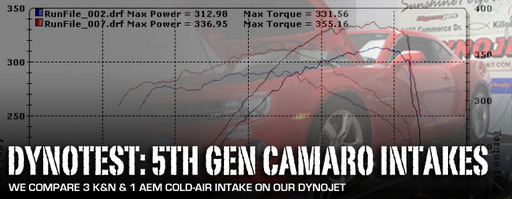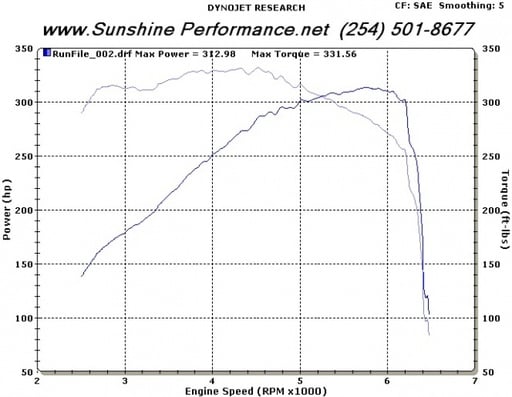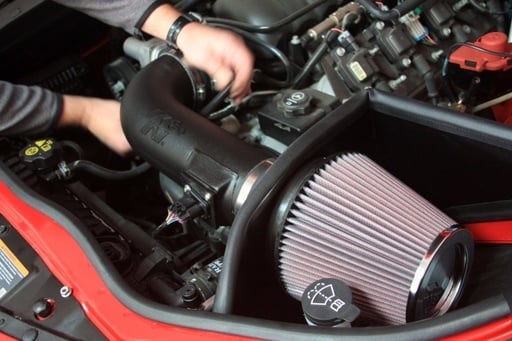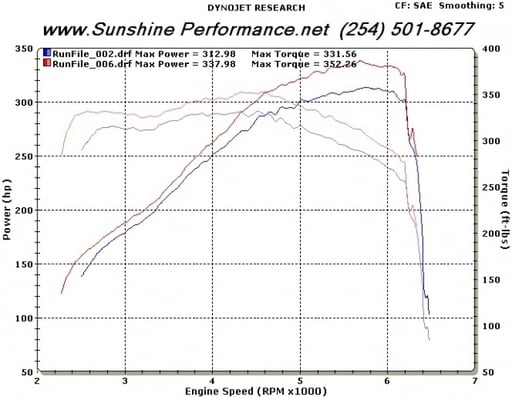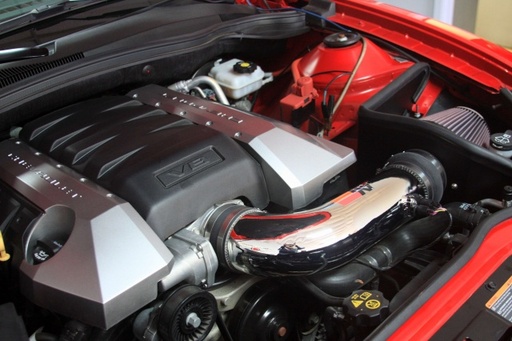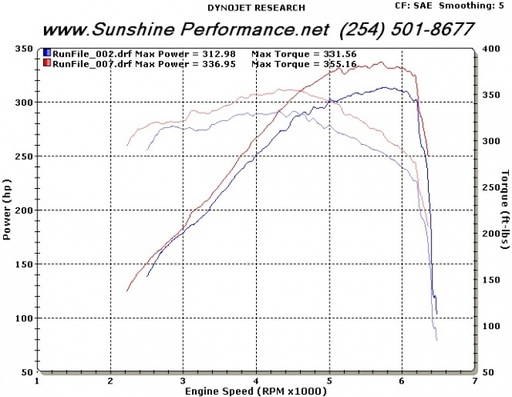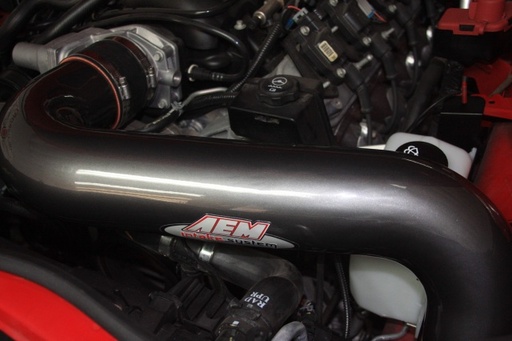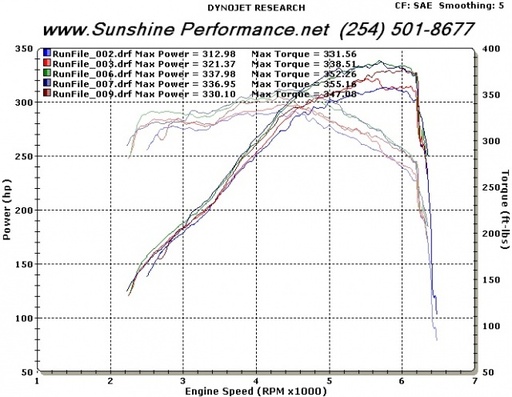In the early days of hot rodding, gear heads would commonly run their engines with no air filter at all to free up as much horsepower as possible. But with modern fuel injected engines, going filter-less generally isn’t even an option, plus all the nasty junk can get sucked into your pricey engine. So we need to run an air filter to protect our engine, but we still want to move more air to make more power. Enter the tried and true cold air intake – the simplest way to free up your intake tract, while keeping your air filtered before it reaches your engine, and for decades no other company has been more synonymous with high flow air filters than the legendary K&N.
The 5th Gen Air Intake category is a hotly contested one, as it’s an easy and cheap bolt-on. K&N and their sister company AEM Intakes offers several different performance intake options for the 5th Gen Camaros, so we decided what better way to find out which one makes the most power than to test each system on the dyno, on the same car, with no other modifications skewing the results. So we hooked up with our good friends at Sunshine Performance in Killeen, Texas, to perform a Shootout of the entire K&N product line for 2010 and up SS Camaros.
The intakes that we tested were:
- Stock Panel Filter
- K&N Stock Replacement Drop-In Panel Filter
- K&N 63 Series Aircharger Intake System
- K&N Series 69 Typhoon Air Intake System
- AEM Cold Air Intake System
Baseline Power Numbers
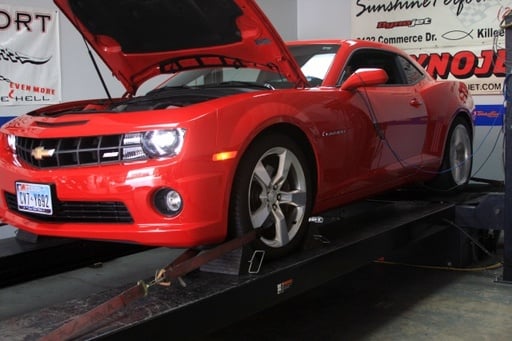
For our test, Mr. Brett Halstead, from Killeen, Texas let us borrow his bone-stock 2010 Camaro SS, with the 400 horsepower L99 and 6L80E slush box, to run on the Dynojet with every intake that K&N makes for the 5th Gen Camaro. Once the guys at Sunshine Performance had the Camaro strapped down, we did a few pulls to establish the Camaro's baseline numbers. The steam produced was 312.9 rear wheel horsepower. All dyno testing was done with the hood up.
If you want to know how far you’ve come, then you have to know where you started. We strapped down the red Camaro to the Dynojet with everything in place that it came from the factory with, and dropped the hammer. Our baseline rear-wheel power numbers for this test are 312.9 horsepower and 331.5 pound feet of torque. You’re probably thinking this seems a bit low considering that the L99 is rated at 400 crank horsepower, but this comes out to a 21.75% drivetrain loss which is definitely within the normal range for automatic transmission cars.
- Baseline Rear Wheel HP: 312.9 HP
- Baseline Rear Wheel Torque: 331.5 Ft/Lbs.
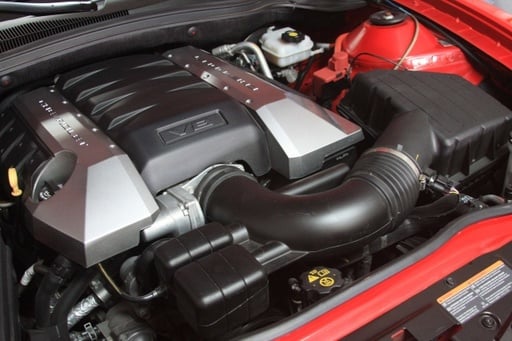
The Camaro's stock air box gets the job done, but what kind of hot rodders settle for just getting the job done? There's horsepower to be had by ditching this black plastic.
K&N Stock Replacement Drop-In Panel Filter
The surprise of our test group – 8 rear wheel horsepower from the simple K&N panel filter replacement.
All dyno runs were done with the hood up. This was the subject of fierce debate. We figured – hood closed was more realistic, but then again, the value of fresh air coming in through the front of the Camaro was negated. There have been a number of dyno tests on open vs. closed hoods, but we decided to leave them open to equalize all of the tests (in our opinion) and to aid cooling.
Once it had cooled down a bit, we ran the SS on the Dynojet and were rewarded with just over 8 rear-wheel horsepower, and an even 8 pound feet of torque thanks to the panel filter. This was a surprise to our test group – 8 rear wheel horsepower is stout for a simple panel filter replacement. You’ll notice that there is a little bobble in the dyno graph probably due to a tiny bit of timing retard – or the K&N panel might have made even more. This may have been more heat related than anything.
If you want to keep the modifications on your Camaro simple, and you plan on keeping your car for a long time, a K&N drop in filter might actually be a good investment that will pay you back every few months when you don’t have to buy a new paper filter. Plus, 8 rear-wheel horsepower isn’t bad at all for a total of about 2 minutes worth of work.
- K&N Panel Filter – Rear Wheel HP: 321.37 HP – increase of 8.4 rwhp
- K&N Panel Filter – Rear Wheel Torque: 338.5 Ft/Lbs – increase of 8.0 ft/lbs
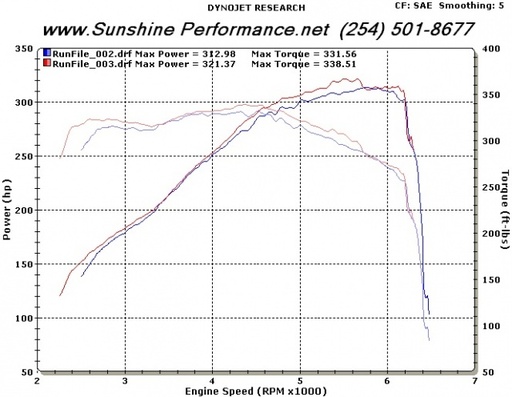
Not a bad little power bump for just replacing the stock filter. Plus, if you can keep your foot out of it, the K&N panel filter might give you a few more MPG's.
K&N 63 Series Aircharger Intake System
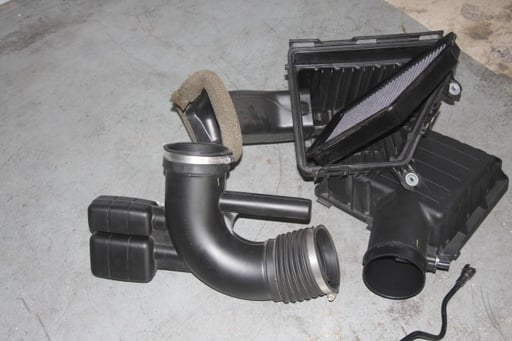
Before the Aircharger system can go in, the old stock junk has to come out. The removal of the stock air box is very straight forward, just don't forget to remove the MAF sensor from the tube on the side of the air box lid. You are going to want to keep that.
Next up in our test is the K&N 63 Series Aircharger Intake System. The K&N Aircharger consists of a molded black intake tube, a conical high-flow air filter, and a heat-shield. The intake tube is made of rotationally molded interlaced high-density polyethylene, which is specially shaped to reduce turbulence in the intake for smoother, faster air flow. The conical air filter is designed to create more surface area to pull air through, as well as catch more dirt.
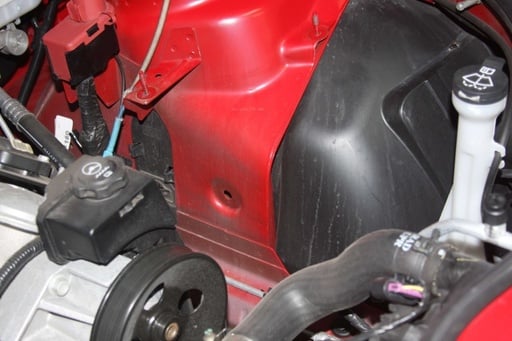
The Aircharger uses all stock mounting points and existing studs for a hassle and fabrication free install.
The install of the Aircharger system is very straight forward.
Remove the stock intake and air box, and be sure to remove your stock MAF sensor from the stock air box lid – you will need it for the new intake. The heat shield doubles as a barrier between the air filter and the heat produced by the engine, and the main support for the intake. The heat shield bolts right to the mounting points of your factory air box, so there’s no need to do any crazy bracket fabrication or drilling on your new Camaro. K&N also supplies great step-by-step instructions and all the necessary hardware to install the Aircharger, so just take your time, and use common sense and you shouldn’t have any problems with the install.
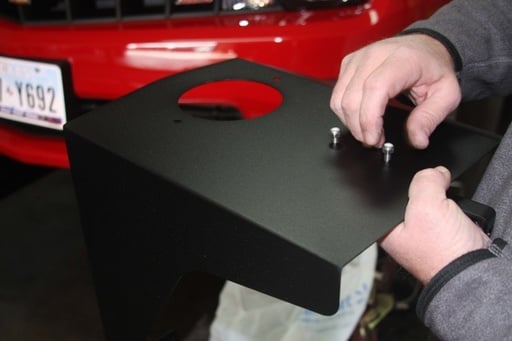
The Aircharger's heat sheild doubles as the intake's mount. Here we are bolting on the lower mounting bracket. The only part of installing the Aircharger that can be a pain in the butt is getting the included hood seal formed around the top of the heat sheild.
With the black tubed K&N Aircharger installed on the Camaro and the engine block still warm to the touch from the previous dyno run, it was time to wind up the L99 once again on Sunshine Performance’s Dynojet. Our best run with the K&N Aircharger netted us 337.9 rear-wheel horsepower and 352.2 pound feet of torque – a net gain of 25 horsepower and almost 21 pound feet of torque at the rear wheels. That’s the kind of power gain that would definitely make a difference in how the car feels on the street, and with a simple intake install we earned back all of power that the L99 gets shorted to the LS3 Camaro SS.
On the aesthetic side of things, the Aircharger system looks like a very high quality OEM stock component under the hood (with the exception of the polished filter cap), and looks like it belongs there. Also, when we took the car to wide-open-throttle on our dyno runs there was a very noticeable difference in the sound of the intake, and a very slight change in the exhaust note of the SS. Over all, the car just sounded more aggressive.
- Baseline Rear Wheel HP: 312.9 HP
- Baseline Rear Wheel Torque: 331.5 Ft/Lbs
- K&N Aircharger – Rear Wheel HP: 337.9 HP – increase of 25.0 rwhp
- K&N Aircharger – Rear Wheel Torque: 352.26 Ft/Lbs – increase of 20.76 ft/lbs
K&N Series 69 Typhoon Air Intake System
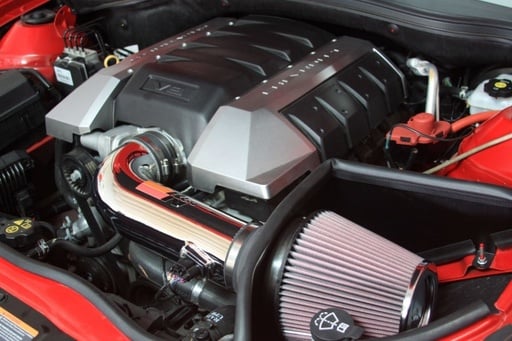
We decided that the gleaming polished aluminum Typhoon intake deserved the engine cover to be included in its Glamor Shots.
The next system we tested is the K&N Series 69 Typhoon Air Intake System, with a polished aluminum intake tube that measures a full 4 inches in diameter on both the filter and throttle body ends.
The intake tube is mandrel bent to prevent flow impeding kinks, and is roughly the same shape as the Aircharger, placing the air filter in the same position on the drivers’ side of the engine bay. Other than the polished aluminum intake tube, the only appreciable difference between the Typhoon and the Aircharger is a small difference in how the MAF bolts up to the intake tube. We compared the heat shields that come with both systems, and they are no doubt the exact same piece. We even cross checked the part numbers for the conical air filters included with both the Typhoon and Aircharger, and they are the exact same number.
So – this as a difference of minor design changes – and materials – aluminum versus plastic.
Since the install of the Typhoon is the exact same process as the Aircharger system, and we are pretty quick learners, we once again found ourselves actually standing around waiting for the engine to cool down from the previous dyno runs after we had the Typhoon intake installed on the Camaro. While we were waiting, we couldn’t help but comment on the fact that the polished Typhoon intake looks spectacular under the hood of the SS. But if there is one thing we’ve learned during our time working on cars, it’s that just because something is shiny doesn’t necessarily mean it will make you any more power.
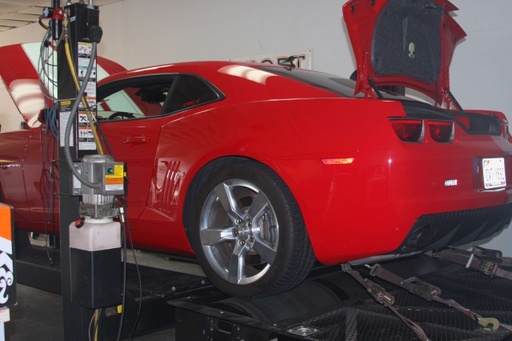
Due to our vast intake install experience (...or just because it is almost the exact same process as the Aircharger...) we were able to get the Typhoon intake bolted together in a matter of minutes, and had to let the engine cool down before we did our test pulls.
So, is the K&N Typhoon intake all style and no substance? Well, as it turns out you can have your under-hood bling with plenty of power to go with it. With the Typhoon, we gained just under 24 horsepower, and over 23 pound feet of torque over stock – that’s just 1 horsepower less than the Aircharger, and 2 pound feet of torque more. Our best dyno numbers for the K&N Typhoon on the L99 SS were 336.9 horsepower, and 355.1 pound feet of torque.
Let’s just say, that power gain is probably within the statistical variance of our dyno. However, if you want to ignore variance, the plastic air charger out powered the aluminum tube intake by 1 hp, but fell short by a few ft/lbs.
- Baseline Rear Wheel HP: 312.9 HP
- Baseline Rear Wheel Torque: 331.5 Ft/Lbs
- K&N Typhoon – Rear Wheel HP: 336.9 HP – increase of 24.0 rwhp
- K&N Typhoon – Rear Wheel Torque: 355.16 Ft/Lbs – increase of 23.6 ft/lbs
It should also be noted that for whatever reason the results of our tests exceeded K&N’s admittedly conservative power estimates of approximately 18 rear wheel horsepower for both the Typhoon and Aircharger intake systems. Buy hey, there’s nothing wrong with being an over achiever, especially when it comes to horsepower, right?
AEM Cold Air Intake System
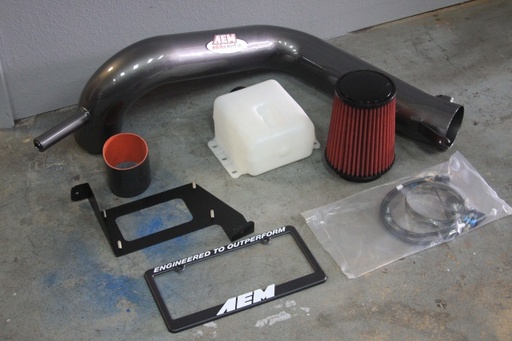
AEM includes everything you need to install their full length cold air intake on your 5th Gen, even a replacement washer fluid bottle and an extended MAF harness.
To mix things up a bit, we also threw in AEM’s full length cold air intake into the shootout.
The AEM cold air intake is a bit of a different animal; instead of placing the filter in the engine bay behind a heat shield like most other intake systems for the 5th Gen Camaro, the AEM snakes the filter all the way down into the driver’s side fender, where it can have access to the coolest ambient air possible, with the idea being that cooler and more dense air will naturally make more power. Now, that being said, we were on the dyno, not the street.
Would this slightly longer intake path produce less power due to additional restriction, or would the cold-air location provide a more dense air charge? Would it even matter on the dyno – because dyno’s aren’t race tracks and certainly not streets where it really matters.
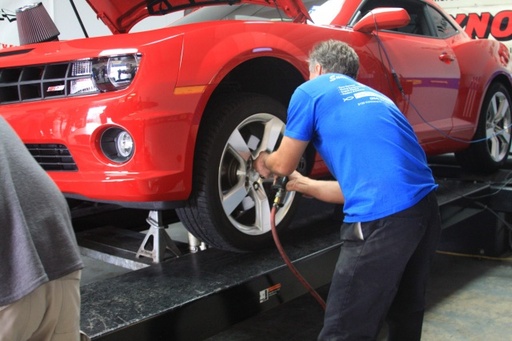
Sure the AEM Intake takes a few extra steps, but its really not that bad. Because of the way Sunshine's dyno is set up, we were able to do the install without even taking t car off the dyno lift. To get the filter down in the fenderwell where it can grab the coolest air possible, the AEM intake's install is a bit more involved.
But to get the filter down in the fender, away from all that power robbing engine heat, takes a bit more work on your behalf. In reality, the install of the AEM system is not that bad, but it is a lot more work than any of the K&N systems we tested.
Check out our full story on the install of the AEM Cold Air intake for all the details, but the basics are that you will need to jack up the car and remove the driver’s side front wheel, take loose the fender well liner, remove the stock windshield washer bottle, snake the AEM tubing down into the fender, and mount the new washer bottle that AEM includes under the hood. That is definitely an over simplification of the install process, but just know that it isn’t all that bad, it just takes more time than most other intakes.
And again, check out our install story for all the step-by-step details.
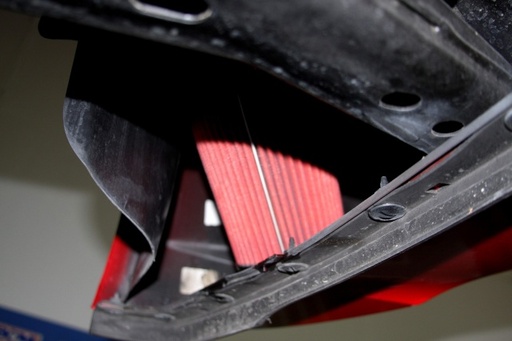
The AEM intake should be able to scoop some serious air when the car is in motion, just be sure to watch out for puddles of water for obvious reasons. In the instructions AEM recommends that you don't drive with this intake in inclement weather.
Don’t instantly disregard the AEM system, because the power it gives up to the K&N intakes might be gained back in real world, on-the-road driving conditions.
Our test SS equipped with AEM intake system spun the dyno to the tune of 330.1 horsepower and 347 pound feet of torque.
That’s down about 7 or 8 horsepower and the same amount of torque from the K&N systems, but still a gain of 17 rear-wheel-horsepower, and 15.5 pound feet of torque over Camaro’s stock numbers. (This is right in the ball part of the gains AEM says you should see with their intake.)
Don’t instantly disregard the AEM system, because it wouldn’t be a stretch to say that most of the power this system gives up to the K&N systems might be gained back in real world, on-the-road driving conditions, where fast moving ambient air is actually flowing across the filter like the system is designed for, rather than sitting stationary on the dyno. Plus, any heat from the engine compartment wouldn’t affect the cold-air location like the standard K&N cold-airs.
Flatly – we should do some track and real-world testing to answer this question fully. However, in the mean time, know that on a static chassis dyno, the cold-air intake produced less power than the engine compartment intake most likely due to the longer air path.
- Baseline Rear Wheel HP: 312.9 HP
- Baseline Rear Wheel Torque: 331.5 Ft/Lbs
- AEM Cold Air – Rear Wheel HP: 330.10 HP – increase of 17.2 rwhp
- AEM Cold Air – Rear Wheel Torque: 347.08 Ft/Lbs – increase of 16.5 ft/lbs
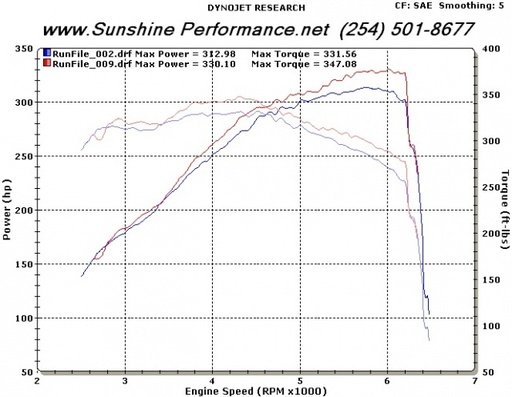
Not bad numbers, but not great compared to the shorter K&N intakes. But the AEM should gain some of that power back when the car actually has cool air moving across the filter when you're driving.
Conclusion
While it’s pretty awesome that you can add around 20 rear-wheel horsepower to your Camaro just by bolting on an intake system, we would love to see just how far a little bit of tuning would go in maximizing the power potential with any of these intakes.
Plus, let’s not forget the compounding effect that other mods, such as headers and a cat-back would have on further freeing up the whole system to gain even more power.
Overall, we have to agree with the common sentiment that a cold air intake is one of the best bang-for-your-buck, as well as bang-for-your-time bolt-ons that you can do with your 5th Gen Camaro. Check out K&N and AEM’s websites for more info on how you can get your engine to go with the flow.
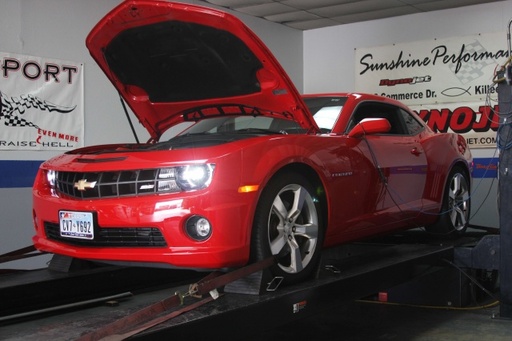
The "Rouge Racer" held up like a champ during our half day dyno test, and didn't give us a bit of trouble. Thanks again to Brett Halstead for letting us beat on his SS in the name of science, and to Sunshine Performance for all their help with our shootout.



